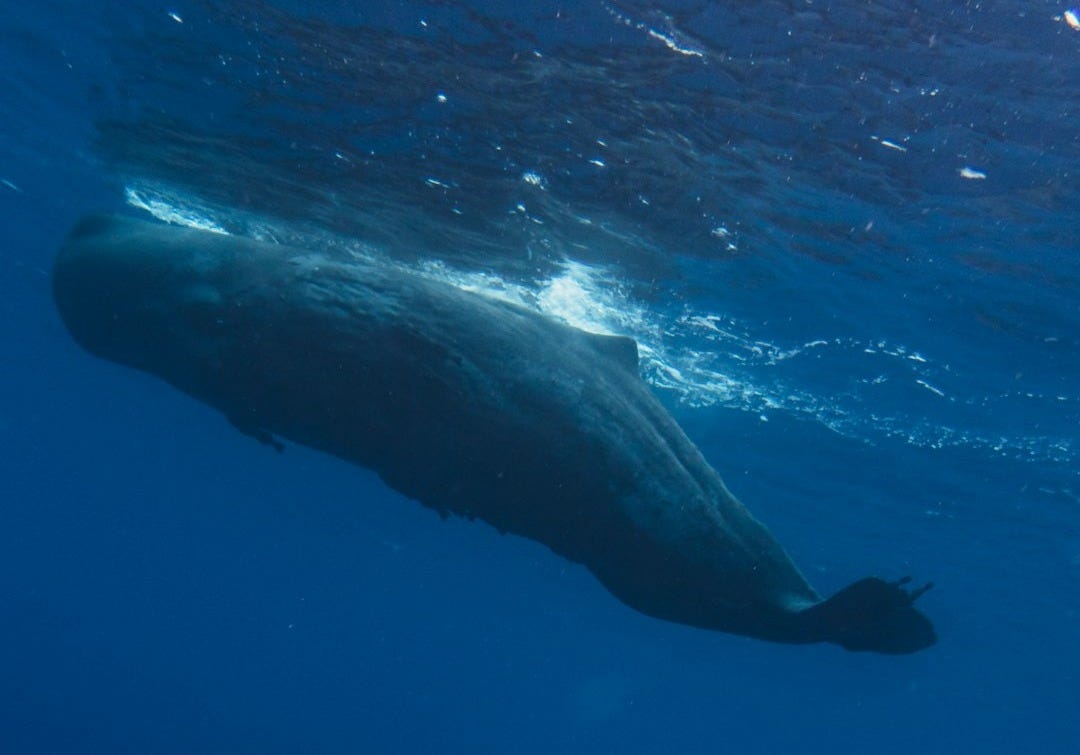Welcome back, readers! This post is a special edition: we’re passing the mic to Manon Wells Jesus, a Cetacean Research & Rescue Unit (CRRU) staff member who is sharing some history and fun facts along with the importance of the recent sighting of Sperm Whales in Scotland.

On Thursday, the 19th June, a small pod of sperm whales was spotted in the shallow waters of the inner Moray Firth.
Sperm whales are the largest of all the toothed whale species (odntocete), with males reaching lengths of 16 meters and weighing up to 60 tonnes. They are pelagic, living in open ocean and have one of the widest distributions of all marine mammal species. While conservation efforts have improved sperm whale numbers, their current status is still listed as vulnerable under the International Union for the Conservation of Nature (IUCN) Red List, but other listings, such as the United States’ Endangered Species Act and Marine Mammal Protection Act, list sperm whales as endangered. Approximately 300,000 individuals remain, compared to the 1.1million that would have been roaming the seas before the whaling boom in the 1800s.
Whalers hunted sperm whales intensely due to the large volume of spermaceit they produce in their heads. An adult male sperm whale can hold up to 1,900 litres of spermaceti. This waxy substance was highly valued for its numerous uses, including cosmetics, mechanical lubricant, and in oil lamps and candles.
Naturally, the spermaceti is also highly valuable to the whales. Originally, people thought it was semen, which is how the whales got their name. But spermaceti is used by echo-locating whales to create and focus sound waves; those sound waves bounce back to a whale’s “melon” and help create a map of the sea. It’s similar to a submarine using sonar to map the contours of the ocean floor and navigate safely. Echolocation is essentially how whales “see” their surroundings, and it’s a critical tool for sperm whales' ability to hunt with precision in the depths of the mesopelagic and twilight zones. This area is about 600 metres deep with minimal light. They prey on squid, sharks and bony fish, all of which would be nearly impossible to see with only their eyes. Sperm whales are not only champions of diving depth, but they can hold their breath for up to 90 minutes, although most dives last about 45 minutes.
While conservation efforts have helped the sperm whale population rebound, their naturally slow reproduction rates mean a slow recovery. This is common in long-lived animals. Their gestation period is about 14-16 months, and calves stay with their mother for at least the first 10 years. Females reach sexual maturity around 9-10 years old, when they reach about 8.8 metres/29 feet long. Each mother whale will produce a calf only every 5-7 years. Additionally, males have a prolonged puberty stage, which can occur from 10 to 20 years old. While many are technically sexually mature at 10 years old, most do not engage in reproduction until their early 20s.
Female calves typically remain in the same social group as their mother, while males often leave to form bachelor groups. Individuals in these small, male pods tend to be around the same age and size. They hunt together and often travel farther than the female pods, heading toward the poles. Upon reaching sexual maturity, males will return to warmer waters to reproduce.
It was one of these bachelor pods that swam up the Moray Firth on Thursday. However, since this area is very shallow for sperm whales, there was immediate concern that they might be in trouble or may become entangled in coastal fishing gear.
The Cetacean Research & Rescue Unit (CRRU) has been involved in marine wildlife rescue since 1999 and operates the only 24-hr response team of marine mammal scientists in northeast Scotland. They assist whales and dolphins in trouble, from beaching to entanglements. Once alerted to the presence of the sperm whales and the potential danger, a team was mobilised to assess the welfare of the group. After a prolonged search, the team finally located the animals.
The CRRU is leading the industry in setting best practice standards for wellness checks and other interactions, like detangling whales from fishing gear. This means the minimum contact necessary for the task at hand. For example, photo identification is critical for understanding the lives of whales and easily done without any disturbance. Photographs are taken with a high zoom DSLR camera, so that each whale could be recognised by the shape of their dorsal fin and the ridges on their backs. This identification technique is used globally, allowing researchers to cross-reference. Other information can be gathered from drones at a safe distance, like using photogrammetry to estimate size. And of course, once the scientists are within range of whales, all sound-emitting devices (from the engine to sonar) are turned off, eliminating interference with whales’ echolocation.
Using these techniques, CRRU was able to determine that the pod of 8 whales was not entangled and appeared to be in good health. The largest member is about 13.3 metres long. The team is circulating the photo ID images with colleagues engaged in long-term studies of Sperm Whales. Together, we are learning that male sperm whales have been reported across the North Atlantic, English Channel, and North Sea, including sightings in the Azores, Denmark, Nova Scotia and Spain. Learning about their travels is not only interesting, but it also helps inform conservation efforts.
For information on what to do if you find a stranded whale or dolphin in the UK, go to: https://crru.org.uk/rescue/stranded, or to make a donation in support of CRRU, please visit: https://crru.org.uk/help/donate






I always wondered how Sperm Whales got their name, haha. So glad to hear this pod is doing well! I thought I saw one once... but I can't be sure. It was far away and I wasn't wearing my glasses.